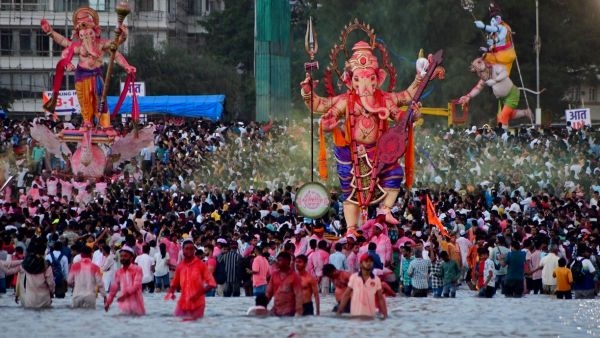When God Returns to the Waters
Every year, as Ganesh Chaturthi culminates, streets echo with chants of “Ganpati Bappa Morya, Pudhchya Varshi Lavkar Ya!” (O Lord Ganesha, come again next year!). The clay idols that were lovingly sculpted, decorated, and worshipped for days are carried in joyous processions before being immersed in flowing waters. This ritual, known as Visarjan, is paradoxical—it is both a celebration and a farewell, laughter mixed with tears, devotion mingled with detachment.

Yet Visarjan is more than a religious ritual. It is a profound metaphor for the psychology of letting go. Across cultures and traditions, philosophers and psychologists have grappled with impermanence, loss, and the art of detachment. From Freud’s theory of mourning to Jung’s archetypes, from Sartre’s existential freedom to the Bhagavad Gita’s call to selfless action, Visarjan embodies universal truths about life, death, and renewal.
Read More: Joy of Diwali
1. Impermanence as the Only Constant
The immersion of the idol is a striking dramatization of impermanence. The form of Ganesha, once vibrant and alive with rituals, dissolves into formlessness.
The Bhagavad Gita reminds us:
“For what is born must die, and what dies will be born again.” (Bhagavad Gita 2.27, trans. Sargeant, 1984)
From a psychological perspective, ritualizing impermanence allows people to confront change with less resistance. Neimeyer (2001), in his work on meaning reconstruction after loss, emphasized that structured rituals help people process endings while finding continuity.
Philosophers across traditions echo this truth. Marcus Aurelius wrote:
“Loss is nothing else but change, and change is Nature’s delight.” (Meditations, Book 12).
The idol’s dissolution teaches a lesson modern psychology also affirms: impermanence is not tragedy—it is life itself.
2. Mourning, Renewal, and the Archetype of Return
In psychoanalysis, Freud (1917/1957) described mourning as the gradual withdrawal of emotional energy from a lost object. Visarjan enacts this process publicly: the community invests affection into the idol, only to release it with ritualized farewell.

But unlike the Western model of mourning, which often emphasizes finality, Indian philosophy views dissolution as return. The Chandogya Upanishad declares:
“As rivers flow into the ocean, losing name and form, so the knower merges with the infinite.” (Chandogya Upanishad 6.10.1)
Here, mourning is not about losing but about recognizing unity beyond form.
Carl Jung’s depth psychology provides another layer. The idol represents the ego-bound self, which must eventually dissolve into the collective unconscious (the water). Jung (1964) argued that symbols like water carry archetypal meaning—immersion signifies rebirth, the psyche’s cyclical renewal.
Thus, Visarjan acts as both grief ritual and rebirth ritual.
3. Existentialism and the Freedom to Release
Existentialist thinkers often highlight the difficulty—and necessity—of letting go. Jean-Paul Sartre (1943/1993) argued that freedom is not freedom from loss, but the freedom to choose how we respond to it:
“Freedom is what you do with what’s been done to you.” (Being and Nothingness)
Visarjan dramatizes this freedom. We do not passively endure the idol’s disappearance; we actively immerse it, transforming loss into choice. Psychologically, this aligns with Acceptance and Commitment Therapy (Hayes et al., 1999), which emphasizes embracing impermanence while committing to meaningful action. Letting go, in this framework, is not resignation—it is an act of agency.
4. The Gita’s Vairāgya
Perhaps the most direct articulation of detachment comes from the Bhagavad Gita:
“You have the right to action, but never to its fruits. Do not be attached to the results of your work.” (Bhagavad Gita 2.47)
This philosophy of vairāgya (detachment) mirrors the psychological concept of goal disengagement. Wrosch et al. (2003) found that the ability to let go of unattainable goals is linked to greater well-being.

Detachment does not mean indifference. For ten days, Ganesha is loved as family—fed, adorned, worshipped. But when the time comes, he is released joyfully. Detachment, then, is not about refusing to love but about refusing to cling. Swami Vivekananda (1899) summarized it beautifully:
“Do not be bound by anything. The essence of Vedanta is that there is but one Being, and that every soul is that Being in full.”
5. Water
Water is central to Visarjan—it is the medium of dissolution. Across cultures, water symbolizes return, cleansing, and transformation. In Jungian psychology, it represents the unconscious, where forms dissolve and re-emerge.
As Lao Tzu wrote in the Tao Te Ching:
“When I let go of what I am, I become what I might be.”
Immersion into water is both literal and symbolic: a return to the formless, a reminder that dissolution is the beginning of transformation. The Isha Upanishad echoes:
“All this is for habitation by the Lord. Whatever is changing, transient, ephemeral—rejoice in renunciation.” (Isha Upanishad, verse 1)
Visarjan thus embodies both renunciation and renewal.
6. Collective Catharsis and Social Bonding
The psychological impact of Visarjan is not only personal but collective. Émile Durkheim (1912/1995) described rituals as producing collective effervescence, moments when individuals lose themselves in shared emotion and reaffirm social bonds.
In Visarjan, grief is not solitary—it is communal. The act of chanting, dancing, and immersing together transforms loss into shared catharsis. From a therapeutic angle, this mirrors modern group therapy, where communal sharing of loss reduces isolation and fosters resilience.
7. Narrative Psychology
Humans make sense of their lives through stories. Narrative identity theory (McAdams & McLean, 2013) shows that people frame losses as parts of larger, meaningful narratives. Visarjan embeds loss into a cyclical narrative: Ganesha departs, but he will return. This story softens grief, turning endings into transitions.
Viktor Frankl (1946/2006) captured this idea:
“In some way, suffering ceases to be suffering at the moment it finds a meaning.”
The meaning of Visarjan is not absence but renewal. The goodbye is softened by the promise: “See you next year.”
8. Lessons in Detachment
The Indian philosophical tradition places non-attachment at the heart of liberation. The Upanishads teach that all forms are transient manifestations of one underlying reality. The idol is not Ganesha himself, but a symbol of the infinite, to be released when its purpose is fulfilled. Western philosophy, too, recognized the value of detachment. Stoics like Epictetus taught:
“Never say about anything, ‘I have lost it,’ but ‘I have returned it.’” (Enchiridion, 1st century CE).
Visarjan embodies this Stoic wisdom: Ganesha was never “owned”—only hosted. Returning him is an act of grace, not loss. Sartre’s existentialism, meanwhile, reminds us that detachment is an active choice, not passive resignation. By immersing the idol, devotees own their freedom to release.
The Psychology of Letting Go
Visarjan is not just a ritual—it is a psychological training in impermanence, grief, resilience, and detachment. It embodies truths echoed across traditions:
- Impermanence is life’s essence (Bhagavad Gita, Aurelius).
- Letting go is freedom (Sartre, Vivekananda).
- Loss is transformation, not finality (Upanishads, Jung).
- Shared rituals turn grief into resilience (Durkheim, Frankl).
In an age that often fears endings, Visarjan teaches us to love without clinging, to release without despair, and to trust that dissolution is the gateway to renewal.
References
Aurelius, M. (2002). Meditations (G. Long, Trans.). Dover. (Original work published c. 180 CE).
Bhagavad Gita. (1984). (W. Sargeant, Trans.). SUNY Press.
Camus, A. (1991). The myth of Sisyphus (J. O’Brien, Trans.). Vintage International. (Original work published 1942).
Chandogya Upanishad. (1996). In P. Olivelle (Trans.), Upaniṣads. Oxford University Press.
Durkheim, É. (1995). The elementary forms of religious life (K. E. Fields, Trans.). Free Press. (Original work published 1912).
Epictetus. (1995). Enchiridion (N. White, Trans.). Hackett Publishing. (Original work published c. 125 CE).
Frankl, V. E. (2006). Man’s search for meaning. Beacon Press. (Original work published 1946).
Freud, S. (1957). Mourning and melancholia. In J. Strachey (Ed. & Trans.), The standard edition of the complete psychological works of Sigmund Freud (Vol. 14, pp. 243–258). Hogarth Press. (Original work published 1917).
Hayes, S. C., Strosahl, K. D., & Wilson, K. G. (1999). Acceptance and commitment therapy: An experiential approach to behavior change. Guilford Press.
Isha Upanishad. (1996). In P. Olivelle (Trans.), Upaniṣads. Oxford University Press.
Jung, C. G. (1964). Man and his symbols. Anchor Press.
Lao Tzu. (1997). Tao Te Ching (J. C. H. Wu, Trans.). Shambhala. (Original work published c. 6th century BCE).
McAdams, D. P., & McLean, K. C. (2013). Narrative identity. Current Directions in Psychological Science, 22(3), 233–238. https://doi.org/10.1177/0963721413475622
Neimeyer, R. A. (2001). Meaning reconstruction and the experience of loss. American Psychological Association.
Rilke, R. M. (1989). Duino elegies (E. Leishman & S. Spender, Trans.). Vintage International. (Original work published 1923).
Sartre, J. P. (1993). Being and nothingness (H. E. Barnes, Trans.). Washington Square Press. (Original work published 1943).
Vivekananda, S. (1899). Jnana yoga: The yoga of knowledge. Ramakrishna Mission.
Wrosch, C., Scheier, M. F., Miller, G. E., Schulz, R., & Carver, C. S. (2003). Adaptive self-regulation of unattainable goals: Goal disengagement, goal reengagement, and subjective well-being. Personality and Social Psychology Bulletin, 29(12), 1494–1508. https://doi.org/10.1177/0146167203256921
Subscribe to PsychUniverse
Get the latest updates and insights.
Join 3,030 other subscribers!
Niwlikar, B. A. (2025, September 6). Ganesh Visarjan as a Metaphor for Letting Go and 6 Revolutionary Lessons It Brings With It. PsychUniverse. https://psychuniverse.com/visarjan-as-a-metaphor-for-letting-go/



